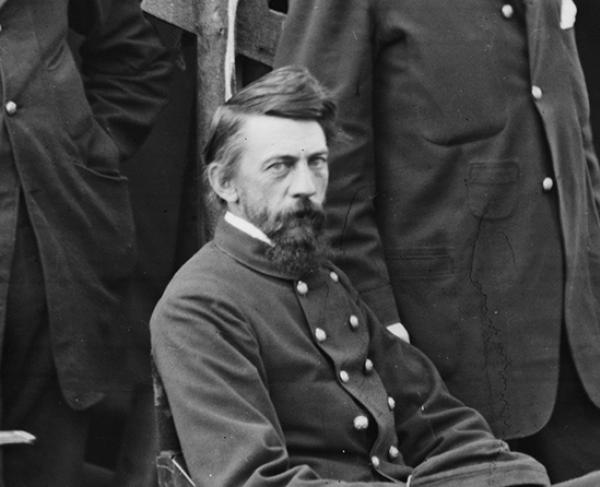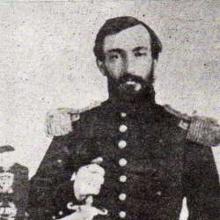Throughout the history of mankind, war and disease have been the bane of the human condition. When war and disease are combined, the situation can become especially dire. In just about every war, disease has felled more soldiers than the enemy. The US Civil War was no different. Malaria and diarrheal diseases were often the main culprits. Even if the disease itself does not kill the individual, in a weakened condition, he might be more susceptible to dying of battle wounds.
Whenever men from varied backgrounds are gathered together as when an army is formed, there is a real threat of diseases (particularly viral respiratory diseases). Even in the modern era, outbreaks of measles and chicken pox can occur among the unvaccinated. For most of history, Smallpox was the most dreaded of these diseases. Under the direction of Dr. Benjamin Church, the Continental Army of George Washington was the first of the world’s armies to be inoculated (technically vaccinated) against this disease using cowpox as a substitute. Diseases of other origins like the Plague were also easily spread under the close, cramped conditions of military camps. The other on the short list of most- dreaded diseases was Cholera. It spreads easily and kills rapidly. It can devastate an army in a very short time.
During the Civil War era, medical care had hardly progressed beyond that of the Middle Ages. Treatments were limited to herbal teas and ‘powders’. Bleeding and leeches are still a common treatment method for a variety of ills.


The single greatest advance was in the use of anesthetics during surgery. The soporific powers of ether and chloroform were recognized and widely used. This came as a great fortune to thousands of men who had limbs amputated. Nothing was known at the time of germs or how infections arose, but the medical practitioners knew of the dangers of gangrene. They became quite adept at removing damaged limbs to spare a life. Unfortunately, the conditions in the ‘hospitals’ following the surgery were quite hospitable to many types of bacteria even though their existence was not yet known. This is to say nothing of the complete and utter lack of anything resembling sterile technique! Saws and instrument were reused without cleaning; no gloves of any sort; no disinfecting the surgical site. But at least in skilled hands the operation was short.
The medical personnel of that era also knew of the risk of contamination of a wound. A bullet or shrapnel could carry with it pieces of the soldiers uniform or other foreign bodies. These needed to be removed or the wound was likely to “fester”. There are many tales of ‘foreign objects’ being removed from wounds. One of the oft told is that of LTG Winfield Hancock whose wound from Gettysburg was not healing well. His surgeon probed deeper and extracted pieces of leather, wood and a bent nail; all apparently from his saddle. The field surgeon had apparently stopped when he extracted the lead shot and did not probe further.
As a result of the war, huge strides were made in prosthetics and facial / dental surgery techniques. MAJ (Dr.) Jonathan Letterman is credited with standardizing and improving the evacuation of casualties from the active battle field. His policies remain in vogue to the present day. While he greatly improved access, there was little he could do about the quality of the care they received.
https://en.wikipedia.org/wiki/Jonathan_Letterman
“Letterman devised a system of forward first aid stations at the regimental level, where principles of triage were first instituted. In other words, Letterman instituted standing operating procedures for the intake and subsequent treatment of war casualties and was the first person to apply management principles to battlefield medicine. He established mobile field hospitals to be located at division and corps headquarters. This system was connected by an efficient ambulance corps, established by Letterman in August 1862, under the control of medical staff instead of the Quartermaster Corps. Letterman also arranged an efficient system for the distribution of medical supplies.”
“The greatest casualties for the Army of the Potomac were suffered at the three-day Battle of Gettysburg in July 1863, but it also showed the efficiency of Letterman’s system, since although the mortality rate of the Army of the Potomac had been 33% during 1862’s Peninsular Campaign, the mortality rate after this bloody three-day battle was only 2%.”
To deal with more than 14,000 Union wounded, along with 6,800 Confederate wounded who were left behind, a vast medical encampment was created northeast of Gettysburg off the York Pike on the George Wolf farm, named “Camp Letterman.”
“Surgeon John McNulty, medical director of that corps, reports that ‘it is with extreme satisfaction that I can assure you that it enabled me to remove the wounded from the field, shelter, feed them, and dress their wounds within six hours after the battle ended, and to have every capital operation performed within twenty-four hours after the injury was received.’ I can, I think, safely say that such would have been the result in other corps had the same facilities been allowed—a result not to have been surpassed, if equaled, in any battle of magnitude that has ever taken place.”
Within the CSA, all the ambulances, facilities and medical supplies were the purview of the Quartermaster Corps. Although most were dedicated and designated with yellow or red flags, occasionally ambulances would be subverted to other uses. The surgeons were passive recipients of whatever was brought to them whenever that occurred. In one sense having all the wagons, ambulances and medical supplies under the purview of the QM Corps was an advantage for the ANV. Whereas under Letterman’s scheme, the Union medics had their own ambulances, when other transport was needed it had to be ‘negotiated’ for. Within the ANV structure, the QM personnel could freely assign wagons to transport the wounded. Sometime they simply sat on top of supplies. Other times, loads would be shifted to free more wagons to carry wounded. At Gettysburg, the medical staff labored under the same problems as the entire ANV: it was spread over a wide area. In addition to often being 1-3 miles away from the fighting (far enough to be out of artillery range), these facilities were too far apart to provide any mutual support. Although it wasn’t precisely regimented, most soldiers were routed to the facility that belonged to their unit, not necessarily the closest one. Records show that the ANV had at least 40 scattered medical facilities; one as far back as the Black Tavern. There was at least one per brigade, division and corps, but many regiments carried along their own dedicated doctor and staff.
Medical facilities and personnel comprised a significant percentage of the logistical (non-combatant) portion of both armies. Although it was a common practice of the era to ‘commandeer’ the use of available buildings for use as surgical facilities and hospitals, both armies carried large numbers of tents to shelter the wounded. Both sides employed non-combatant troops such as musicians and wagon masters to assist within the medical facilities. On the CSA side they had one other resource: slaves. Although no records survive (if they were even kept), it is estimated that Lee had between 6 and 10 thousands slaves in his ranks. Most were there to do manual labor like erecting and dismantling tents; cooking food or doing maintenance on the wagons. Others were assigned to look after the large herds of livestock that accompanied these armies on the move. In addition, most CSA officers and even some enlisted were attended by their own personal slaves. Should his ‘master’ be wounded, he would care for him in the medical facility. Following a battle, large numbers of slaves would be seen carrying lanterns searching for their dead or wounded ‘masters’. One side-effect of such activity is that slaves would “suddenly find themselves among the Union lines”!
Staffing was usually quite adequate, even if the training of the lower level personnel was rather inadequate. Each Regiment (5-800 men in the ANV) had 50-100 designated medical personnel plus other non-medical, non-combatant personal who were assisting. The surgeons were mostly pre-occupied with amputations. Any other wound was left to “nurses” (many with no training what so ever) and medical “attendants” to clean and dress the wounds. Of course, no fluids were available as a medical intervention against blood loss. The best that could be done was to feed them water by mouth if they were conscious. Many wounded were never even seen by an actual doctor.
It is hard for us who live in this modern, clean world to even imagine what a Civil War era medical tent must have been like. First there was the stench: blood, festering wounds, piles of limbs, feces and urine intermingled. Next there were the flies. Since these facilities were as often as not in or near barns, flies abounded. Written accounts describe flies layered onto the corpses as if a blanket. With flies come maggots; first on the dead bodies then in the wounds. Sanitation was a major ‘issue’ in and around such facilities. The longer the wounded remained, the worse it got. And then, of course, the flies added to the spread of diarrheal disease in already weakened men. If a soldier stayed in any hospital long enough, he was at risk of being struck down by typhoid and/or scurvy. Sanitation was compounded by the building put to use as hospitals. As often as not these were churches and barns. Barns had the obvious problem of flies and manure from their occupants. Churches were better but rarely had a water supply or latrine facilities.
Once Lee made the decision to abandon the field and head back to Virginia, a series of major decisions needed to be made. Who among the wounded could accompany the retreating force and who had to be left behind? Modern convention is that the abandoned wounded would be treated as well as possible, if second class to one’s own wounded. But to ensure the minimal losses, some medical personnel inevitably had to stay with the men until Union forces arrived to take charge. Hard decisions need to be made as to who among the wounded were evacuated and who left to be captured. Similarly, which of the medical personnel were to be ‘sacrificed’? Sometimes these men would volunteer. For example, a regimental doctor might stay with his men since they were essentially neighbors. Sometimes relatives would chose to stay with their wounded cousin or brother.
ANV Medical Director Guild took charge of this action. As the travelling wounded were loaded into the wagons, the remaining medical facilities were consolidated and the minimal number of ‘attendants’ were left to care for them. Most of this had to take place in the dark, but the facilities were far enough west that they were generally out of sight of any Union disruption. As many as 20% of the wounded had to be left either due to the severity of their wounds or for lack of transportation. Some 4000 seriously wounded were left to the Union’s care. For the wounded of the ANV, many might have wished that they had been left behind; the journey turned into an agonizing ordeal that lasted many days. After enduring hours rocking and jostling in a wagon, some would jump out and simply lie by the roadside to rest risking eventual capture or even death from lack of water.
